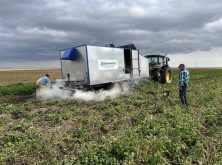In 2016, so many U.S. farmers spaying dicamba had spray drift problems that the U.S. Environmental Protection Agency released a compliance advisory in August citing “an unusually high number of reports of crop damage that appears related to misuse of herbicides containing the active ingredient dicamba.”
The EPA advisory said: “Extension experts across the country believe that illegal use of dicamba products on adjacent or nearby dicamba-resistant cotton and soybean crops caused the observed crop damage.”
Dicamba became a problem because dicamba-resistant Roundup Ready 2 Xtend soybeans were on the market in 2015 and 2016. These soybeans are resistant to both dicamba and glyphosate.
Read Also

Claas brings 1000 Series SP forage harvesters to Canada
In mid-August, Claas unveiled its new line of Jaguar forage harvesters at an event in Visalia, California, deep in the heart of that state’s dairy region.
- Read more: Herbicide drift not always wind-based
- Read more: Maximize your sprayer productivity
In November, Dr. Tom Wolf, applications specialist with AgriMetrix Research & Training, spoke in Weyburn at one of four Saskatchewan oilseed producer meetings. Wolf talked about the dicamba issue and told participants, “Dicamba kills soybeans. If they’re not tolerant, soybeans are the most sensitive crop to dicamba there is.”
On November 9, 2016, the U.S. EPA approved a new dicamba product for use with Monsanto’s dicamba- and glyphosate-tolerant Roundup Ready 2 Xtend soybeans. It’s called XtendiMax with VaporGrip technology. It’s a Group 4 herbicide.
Wolf described this product as “Banvil II with something to reduce volatility.”
Monsanto’s press releases say: “VaporGrip Technology effectively reduces dicamba acid from forming in solution. If acid can’t form, it can’t volatilize.”
Farmers tank mixing this new product with glyphosate will need to use an ultra-course spray. “That’s the coursest spray we know how to make,” Wolf said. “There’s only very few nozzles that can actually make it.”
In fact, the XtendiMax with VaporGrip label specifies that, in order to reduce spray drift, growers may only use Tee Jet TTI11004 nozzles, with a maximum operating pressure of 63 p.s.i., or other specifically listed nozzles at specific pressures.
When these soybeans eventually become available to farmers on the Canadian prairies, soybean growers are “absolutely going to be switching nozzles for specific tank mixes,” Wolf told Weyburn farmers.
“It’s just going to get more complicated, and you might as well get familiar with this kind of thinking.”
Monsanto estimates that 18 million U.S. acres of Roundup Ready 2 Xtend soybeans and Bollgard II XtendFlex cotton will be sprayed with XtendiMax. BASF’s new Engenia dicamba herbicide is also on the market.














